This CE Center article is no longer eligible for receiving credits.
In contrast to patrons of super-loud restaurants who are oblivious of the fact that 90-plus decibels of sound can cause permanent damage to hearing, occupants of modern buildings are very much aware of noise, so much so, that their complaints about airborne and impact noise are a major source of building dissatisfaction.
Acoustics are increasingly recognized as an important feature of building design. Already playing a significant role in LEED® school construction, acoustics are contributing to LEED points in other types of construction. Given the number of projects that require special attention to sound control from concert halls to offices, plus the fact that conventional construction of floors, walls, and ceilings is often inadequate for controlling unwanted sound, design professionals benefit from knowledge of the principles of sound, plus methods for its control.
Measuring sound
Sound travels in waves. In solid building materials, it progresses as vibration. Building materials, such as stud walls, glass windows and concrete floors vibrate at a variety of frequencies when excited by sound or vibration. What we hear are fluctuations in air pressure produced by the vibrating surfaces.
Decibel (dB).
The decibel is commonly used in acoustics to quantify sound levels relative to a 0 dB reference, the typical threshold of perception of an average human
Hertz (Hz).
Sound frequency is measured in Hertz (Hz), cycles per second. The frequency of the fluctuation in pressure determines the pitch. Most sounds are a combination of many frequencies. The human voice or a diesel generator produce sound across many frequencies. An example of a single frequency is the striking of a piano key producing a single note. The 1st (lowest) key is 27 Hz. The 88th key is 4186 Hz.
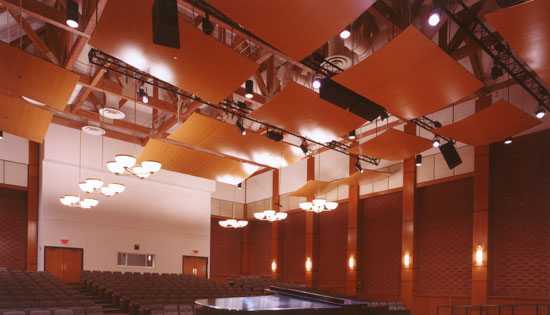 |
Wood veneer reflectors manage acoustics at Susquehanna University, Selingsgrove, PA.
Photo provided by Kinetics Noise Control |
Spectrum band analysis.
The application of acoustical finish materials or the design of a floor/ceiling assembly will depend on the frequencies needing to be controlled.
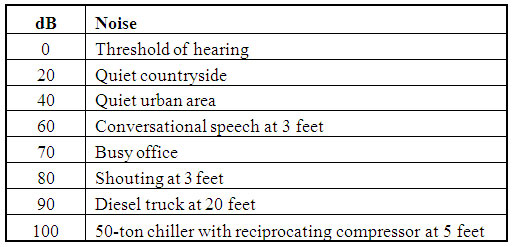 |
Decibel levels of different sounds.
Provided by Kinetics Noise Control |
For purposes of analysis, sound is divided into frequency bands. A spectrum band analysis plots sound (decibels or dBs) against frequency (hertz or Hz).
A-weighting (dBA).
In the measurement of loudness, an A-weighting filter on the sound meter is commonly used to emphasize frequencies from 1000 to 8000 Hz where the human ear is most sensitive, while attenuating very high and very low frequencies to which the ear is less sensitive. The aim is to ensure that measured loudness corresponds with subjectively perceived loudness.
Frequency ranges
Frequency range in Hz depends on the source of the sound. The range of frequencies that young people (under age 25) are able to hear is 20 Hz to 20 kilohertz (one kHz equals 103 Hz). People’s ability to hear high frequencies decreases with age.
The application of acoustical finish materials or the design of a floor/ceiling assembly will depend on the frequencies needing to be controlled.
 |
Frequency range varies by source and is diminished with age
Provided by Kinetics Noise Control |
Sound wave length.
High frequency sounds have a shorter wave length. A 2000 Hz sound, for example, has a 7-in. wavelength. Low frequency sounds have a longer wavelength; a 125 Hz (low frequency), for example, has a 9-ft wavelength.
Low frequency (longer) sound waves are difficult to control with standard building materials.
 |
Noise Criteria establishes background noise across various frequencies
Provided by Kinetics Noise Control |
Noise criteria (NC)
NC curves establish the desirable background sound levels. Because higher frequencies are heard as louder than lower frequencies of the same dB level, NC curves allow higher dB levels at lower and lower frequencies.
Established in the U.S., NC rates indoor noise for various spaces. NC is a single numerical index commonly used to define design goals for the maximum allowable background noise in a given space. They primarily apply to the noise produced by a ventilation system, but they may be applied to other noise sources. The NC criteria consist of a family of curves that define the maximum allowable octave-band sound pressure level corresponding to a chosen NC design goal. As an example, a private office space would require a lower NC rating than a lobby area.
 |
Sound reflects off hard surfaces and is absorbed by softer surfaces.
Photo provided by Kinetics Noise Control |
Room acoustics
Sound reflection in a room can be compared to light reflection. Light reflects most brightly from light colored or mirrored finishes. Sound reflects with little energy loss from hard surfaces like concrete or gypsum board. A soft surface such as carpet or curtains (dark surfaces for light) will not reflect as much sound.
Various materials reflect sound at varying degrees and at different frequencies. Concrete will reflect about 99 percent of the sound that hits it, and a 2-inch-thick acoustical panel will reflect 5 percent. The typical 2-inch thick acoustical panel will not be as effective at absorbing lower frequencies versus higher frequencies. Carpet only absorbs high frequencies. Sound absorption is the opposite of sound reflection. A very small amount of sound in higher frequencies is absorbed by air.
Implementing sound absorption strategies can reduce both the noise level by as much as 8-10 dB while also reducing the reverberation time. Properly applied absorptive materials will improve speech intelligibility and the clarity of music. However, too much absorption makes the space too “dead.” Too little absorption makes the space too “live.” The shape and volume of the room are important components along with the amount of sound absorption and where it is located. It should be noted that sound absorption materials, standing alone, do little to “block” noise or reduce sound transmission.
 |
Noise Reduction Coefficient (NRC) represents sound energy absorbed.
Provided by Kinetics Noise Control |
Noise reduction coefficient (NRC)
Noise reduction coefficient (NRC) is a single number measure of the amount of sound energy absorbed when striking a particular surface. An NRC of 0.00 indicates very high reflection; an NRC of 1.00 indicates very high absorption. NRC is the arithmetical average rounded to the nearest multiple of 0.05, of the absorption coefficients for the 250, 500, 1000, and 2000 Hz frequencies. The sound absorption coefficients of materials are commonly determined through use of standardized testing procedures, such as ASTM C423.
NRC is most commonly used to rate general acoustical properties of acoustic ceiling tiles, baffles, and banners, office screens, and acoustic wall panels. It is occasionally used to rate floor coverings and construction materials.
Sabin. The unit measure for sound absorption is the Sabin, named after Wallace Clement Sabine (1868-1919) who was a pioneer in architectural acoustics. One Sabin is the sound absorption provided by 1 sq ft of a perfectly absorptive surface whose absorption coefficient is 1.0, such as an open window. Sound goes through the window with no reflected energy back into the space. Many acoustical products have high sound absorption coefficients in various frequencies.
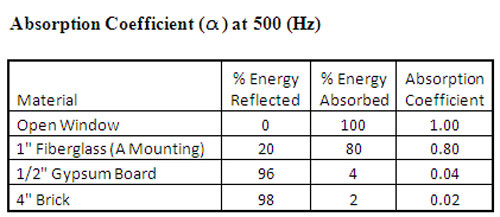 |
Absorption Coefficient (α) describes ability of material to absorb sound.
Provided by Kinetics Noise Control |
Absorption coefficient
The sound absorption coefficient describes the ability of a material to scatter or diffuse sound expressed as a fraction of incident sound. The sound absorption coefficient is frequency-specific and ranges from 0.00 to 1.00. For example, a material may have an absorption coefficient of 0.50 at 250 Hz, and 0.80 at 1,000 Hz. This indicates that the material absorbs 50 percent of incident sound at 250 Hz, and 80 percent of incident sound at 1,000 Hz. In some cases, the coefficient can exceed 1.00. The arithmetic average of absorption coefficients at mid-frequencies, 250 to 2000 Hz, is the noise reduction coefficient (NRC). It is worth noting that the NRC measurement does not include lower frequencies which are important in many applications. NRC should be considered a method of broad comparison for various sound absorptive materials. Measurements are done according to a standard test method such as ASTM C423.
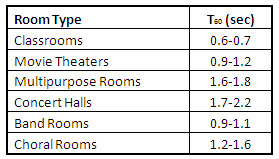 |
Desired reverberation time (T60)) varies according to the space.
Provided by Kinetics Noise Control |
Room reverberation
Reverberation levels are controlled by the room shape and volume and by adding absorptive material content in the room.
T 60 = .049 V/A
T 60 = Reverberation time (60 dB decay) in seconds
V = Room volume, cubic feet
A = Total room absorption in Sabins
Achieving sound control
In order to select the most effective sound control building system and materials, design professionals are well served by consulting an acoustical engineer whenever acoustic performance is highly important to the project. Addressing the issue during the design stage, yields the most economical and effective solutions. Leading manufacturers typically provide specifications and product performance and fire test reports on their web sites. They also can easily import product details into specifications, documents or plans in AutoCAD, REVIT (BIM) and PDF format.
The key areas for achieving sound control include:
* Finishing Treatment and Surface Shaping within Rooms.
- Absorption
- Reflection
- Diffusion
* Sound isolation between rooms
- Airborne: speech, music, noisy HVAC equipment, air traffic are some examples.
- Structure-borne: footfalls, carts or furniture moving on floor, fitness activity & equipment on floor, adjacent railway or parking garage.
It should be noted that for A/V systems or electronic sound reinforcement to be effective, the room should first have the required sound control treatment.
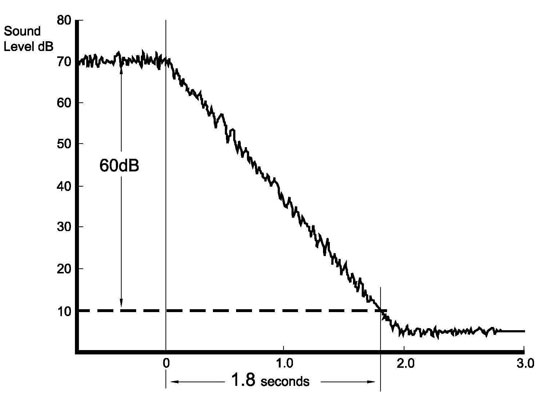
|
Increased absorptive materials and reduced reverberation improves speech clarity and intelligibility
Provided by Kinetics Noise Control |
| LEED® requirements |
Sound control can contribute to LEED points in several categories.
LEED 2009 Schools New Construction and Major Renovations
Indoor Environmental Quality (IEQ) Prerequisite 3: Minimum Acoustical Performance Required
Intent
To provide classrooms that are quiet so that teachers can speak to the class without straining their voices and students can effectively communicate with each other and the teacher.
Requirements
Background Noise
Achieve a maximum background noise level from heating, ventilating and air conditioning (HVAC) systems in classrooms and other core learning spaces of 45 dBA.
AND
Reverberation Time
Design classrooms and other core learning spaces to include sound absorptive finishes to sufficiently limit reverberation in classrooms and other core learning spaces.
CASE 1. Classrooms and Core Learning Spaces < 20,000 Cubic Feet (560 Cubic Meters)
For classrooms and core learning spaces less than 20,000 cubic feet (560 cubic meters), options for compliance
include:
OPTION 1. Minimum NRC
For each room, confirm that the total surface area finished with a material with a Noise Reduction Coefficient
(NRC) of 0.70 or higher equals or exceeds the total ceiling area (excluding lights, diffusers and grilles).
OR
OPTION 2. Compliance with ANSI Standard S12.60-2002 or Non-U.S. Equivalent.
Revised ANSI S12.60-2010/Parts 1 & 2 relate to classroom acoustics for permanent schools (Part 1) and relocatable classrooms (Part 2). (Copies are available for free download from the Acoustical Society of America: http://asastore.aip.org/shop.do?pID=594
IEQ Credit 9: Enhanced Acoustical Performance (1 Point)
Intent
To provide classrooms that facilitate better teacher-to-student and student-to-student communications through effective acoustical design.
Requirements
Sound Transmission
Design classrooms and other core learning spaces to meet the Sound Transmission Class (STC) requirements of ANSI Standard S12.60-2002, Acoustical Performance Criteria, Design Requirements and Guidelines for Schools, except windows, which must meet an STC rating of at least 35. Projects outside the U.S. may use a local equivalent to ANSI Standard S12.60-2002.
AND
Background Noise
Reduce background noise level1 to 40 dBA or less from heating, ventilating and air conditioning (HVAC) systems in classrooms and other core learning spaces.
LEED® 2009 Schools New Construction and Major Renovations includes potential technologies and strategies for achieving IEQ Prerequisite 3 and IEQ 9.
LEED 2009 New Construction and Major Renovations
Materials and Resources (MR) Credit 4: Recycled Content 1–2 Points
Intent
To increase demand for building products that incorporate recycled content materials, thereby reducing impacts
resulting from extraction and processing of virgin materials.
Requirements
Use materials with recycled content such that the sum of postconsumer recycled content plus 1/2 of the preconsumer content constitutes at least 10% or 20%, based on cost, of the total value of the materials in the project.
Many common acoustical materials contain 30 percent or more recycled content.
MR Credit 5: Regional Materials (1–2 points)
Intent
To increase demand for building materials and products that are extracted and manufactured within the region, thereby supporting the use of indigenous resources and reducing the environmental impacts resulting from transportation.
Requirements
Use building materials or products that have been extracted, harvested or recovered, as well as manufactured, within 500 miles of the project site for a minimum of 10% or 20%, based on cost, of the total materials value.
LEED Pilot Credit Library
Pilot Credit 24: Acoustics for new construction and commercial interiors covering a wide range of applications.
Pilot Credit 47: Acoustic Comfort for homes and mid-rise. For details see http://www.usgbc.org/DisplayPage.aspx?CMSPageID=2104 |
Finishing Treatment and Surface Shaping within Rooms
Adding absorption reduces reverberation and unwanted sound reflections. Adding absorption reduces in room noise levels.
Adding reflection and diffusion redirects and scatters sound in order to enhance the listening experience.
Sound absorption
Materials that control reverberation time include absorptive panels, absorptive baffles, carpet, upholstery—and people.
Panels and baffles are the most effective broadband absorbers. Thicker panels better absorb low frequency sound. There are also acoustical panels on the market that are designed for improved low frequency absorption.
Since people absorb higher frequencies, the number of people occupying a space at different times must be factored into the acoustic design.
 |
Acoustical panels absorb sound.
Photo provided by Kinetics Noise Control |
 |
A cloud system of acoustical panels in a media room does not interfere with lighting or sprinklers.
Photo provided by Kinetics Noise Control |
 |
High-impact-resistant perforated metal acoustical panels that are 1-1/8-inch-thick typically have an NRC value of 1.00.
Photo provided by Kinetics Noise Control |
 |
Panels designed for moist pool environments reduce reverberation and noise in otherwise super reverberant natatoriums.
Photo provided by Kinetics Noise Control |
 |
Acoustical materials come in a variety of finishes, including perforated wood.
Photo provided by Kinetics Noise Control |
Traditional acoustic wall panels. With its variety of shaped edges and panel thicknesses, the traditional acoustical wall panel offers design versatility and a solution for controlling reverberant noise while also controlling sound reflections in the room. Fiberglass core acoustical panels faced in fabric or vinyl can be placed on the walls or ceiling. Typically they are fabricated from 6-7 PCF fiberglass board with edges chemically hardened for durability. Maximum panel sizes are typically 4 ft. x 10 ft. Angled or contoured perimeter cut custom shapes can be specified. A 2 in. thick panel typically has an NRC value of 1.00.
Applications include any interior surfaces where superior acoustical performance is required, such as conference rooms, auditoriums, churches, media rooms and office spaces.
Cloud system. For enhanced reverberant noise absorption, an acoustical cloud system of acoustical panels can be used in spaces where ceilings are too low for vertical baffle installations. Cloud panels can be located to not interfere with sprinkler or lighting and can be backlit with low voltage lighting.
High impact acoustical wall panel. For applications where acoustical performance must be teamed with greater durability, such as in gymnasiums, a high impact panel can be specified. A typical two-part panel has a 6-7 PCF density core with a 1/8 in. thick, high density impact resistant skin laminated on the core face.
Corrosion-resistant aluminum or galvanized steel panels. These are suited for controlling reverberant noise problems in gymnasiums, natatoriums, and recreation centers. Some manufacturers fill panels with a 2-in.-thick, glass fiber sound absorber encapsulated in a heat sealed poly vinyl bag.
Wood-faced absorption panels. One typical panel is made with a ¾-inch-thick MDF core with a laminated hardwood veneer facing that is perforated. Designers can select from different perforation patterns and wood types Each panel is backed with an acoustically transparent black fabric to visually cover the sound batting, furring, and attachment hardware, which make up the substrate behind each panel.
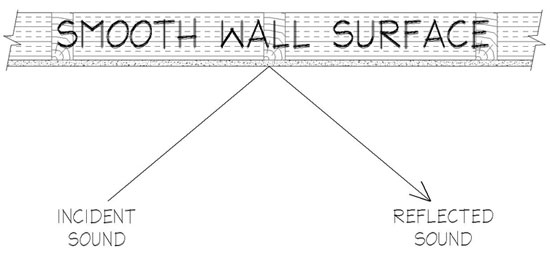 |
Specular sound reflections off of flat wall and ceiling surfaces often produce inconsistent poor acoustic quality throughout the listening space;
Image provided by Kinetics Noise Control |
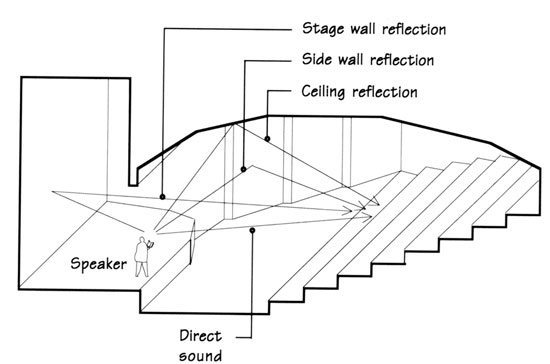 |
Reflective design in an auditorium or lecture hall. Ceiling and wall shaping directs sound to mid and rear seating areas.
Image provided by Kinetics Noise Control |
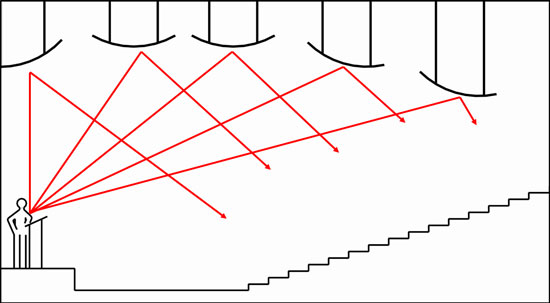 |
Curved acoustical reflectors direct and diffuse sound to the seating area of the auditorium.
Image provided by Kinetics Noise Control |
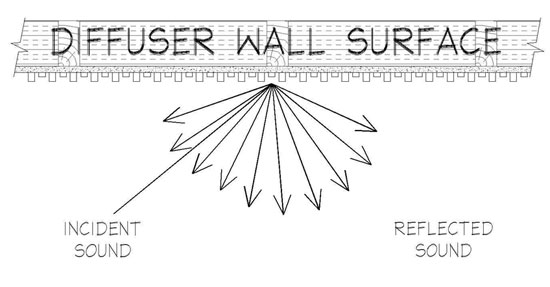 |
In a diffuse sound field sound level is uniform in all locations and from all directions.
Image provided by Kinetics Noise Control |
 |
Suitable for band and choral rehearsal rooms and performance spaces, barrel and geometric diffusers disburse sound reflections evenly throughout the space.
Photo provided by Kinetics Noise Control |
 |
For high level performance spaces, quadratic diffusers are designed with variable well depths based on a mathematical sequence
Photo provided by Kinetics Noise Control |
Sound reflection
Acoustical reflection is often desirable in critical listening environments versus the absorption and deadening of sound energy. Higher frequency sound reinforcement through early reflections off of the walls adds brilliance to music and improves speech intelligibility. Higher frequency sound is easily absorbed by common materials such as curtains, fabric covered chairs and people’s clothing. Designing a room to create a scattering of high frequency sound reflections is preferable and often required to prevent unwanted flutter echo. There are two types of sound reflection: Specular reflection and diffuse reflection.
Specular. Specular reflection is the mirror-like reflection of sound waves from a surface, in which sound from a single incoming direction is reflected into a single outgoing direction.
Diffusion. A diffuse sound field is designed to create uniform sound levels in all locations and from all directions. With adequate sound diffusion, each listener has the feeling of being “enveloped” in sound.
 |
A tuned absorber/diffuser panel acoustically optimizes the hole pattern in the laminate while maintaining the desired overall open versus reflective area in the panel surface.
Photo provided by Kinetics Noise Control |
Compared to a reflective surface, which will cause most of the energy to be reflected off at an angle equal to the angle of incidence, a diffuser will cause the sound energy to be radiated in many directions, hence leading to a more diffusive acoustic space.
Over the years, manufacturers have developed many different diffusers for high performance facilities. They also offer panels that provide both absorption and diffusion:
Geometric-shaped diffusers break up direct sound reflections and disburse them more evenly throughout the listening space.
Quadratic residue diffusers invented in the 1970s by Dr. Manfred Schroedor diffuse sound in a predictable manner. Made from strips of wood material with different depths placed in sequence, their ability to diffuse sound evenly has long been tested and documented.
Adding reflection and diffusion
Wall and ceiling panels are available that provide both absorption and diffusion where low and mid-frequency absorption is desired in conjunction with increasing reflectivity and diffusion in higher frequencies. A typical assembly is a sound absorptive fibrous core covered with a variable impedance laminate. Openings in the laminate are sized and spaced to optimize the absorption in lower frequencies while creating random mid and high frequency reflective surfaces between openings.
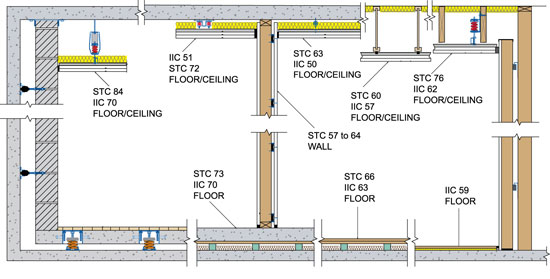 |
Typical flooring, wall and ceiling STC and IIC values achieved through integrating acoustical products within framing designs.
Illustration provided by Kinetics Noise Control |
Sound isolation between rooms
Airborne and structure-born sounds between rooms can be managed by specifying architectural sound isolation assemblies that utilize three principles:
Mass of construction materials such as concrete slabs or plywood subfloors.
Airspace between construction components.
Resilient isolation element used to integrate mass and airspace.
Sound Transmission Class (STC) and Impact Insulation Class (IIC) are two performance values associated with sound isolation between rooms.
Sound Transmission Class (STC) is a numerical rating of how well a building partition attenuates airborne sound. In the USA, it is widely used to rate interior partitions, ceilings/floors, doors, windows and exterior wall configurations (see ASTM International Classification E413 and E90.) The measurement is heavily weighted in the 1000 to 4000Hz frequency. Normal speech can be clearly understood through a wall with an STC of 30. At STC 40 speech can be heard with some effort. At STC 60 loud speech is inaudible but loud music can still be heard, especially loud bass notes. The Uniform Building Code (UBC) states that hotels and multi-family units are required to have an STC of 50.
Impact Insulation Class (IIC)
IIC is a single number rating that provides a means of comparing the acoustical performance of floor-ceiling assemblies, when excited by impact such as footsteps.
The IIC is derived from ASTM method E989, which in turn uses a tapping machine specified in ASTM method E492. A larger number means more attenuation.
 |
Isolating sound reducing blanket of insulation has floor supporting resilient pads.
Photo provided by Kinetics Noise Control |
 |
A concrete slab covered in roll-out isolation material with resilient pads supporting a plywood and hardwood finish floor increases STC to 66 and IIC to 63.
Image provided by Kinetics Noise Control |
Sound isolation floors
Footsteps and impact noise can be intrusive to occupants in spaces below. Construction that calls for hard floor surfaces such as hardwood flooring, ceramic tile, quarry tile, marble, wood parquet, and vinyl tile are all areas where impact noise is of concern.
With no additional sound isolation system, a 6-inch concrete slab has an STC of 53 and an IIC of 27. With hard floor surfaces on the concrete, the floor system falls well below the UBC requirement of IIC 50 for multi-family type buildings. Adding properly engineered resilient materials in the middle of the floor/ceiling sandwich will increase STC and IIC.
Roll-out isolation material. One typical roll-out isolation system creates an airspace of one to four inches with resilient isolators spaced according to design criteria. The roll-out isolation material can be installed beneath a “floated” concrete slab or other built up floor system utilizing cross-laid plywood sheathing. Installed between concrete slabs, the assembly STC and IIC can be 72 and 62 respectively. These values surpass the performance of continuous underlayments due to the airspace and lower natural frequency created by the isolators. Applications include high performance noise control spaces such as dance studios, rooftops where flyover noise is an issue, noisy mechanical equipment rooms over classrooms, and more (see Galaxy Lanes Case Study). Any room where high levels of airborne or structure borne noise are created over an occupied space would be a candidate for this type of systems.
Low profile underlayment. While having lower STC and IIC values than 1-to 4-inch-thick pads and batting, low profile resilient underlayments are a lower cost material primarily designed to improve the impact noise rating (IIC).
Recycled rubber.One environmentally friendly noise control low profile floor underlayment is 98 percent post-consumer and post-industrial recycled rubber. A 3 mm underlayment beneath hard flooring and on top of a 6 in. concrete slab can achieve STC and IIC values of 50 each.
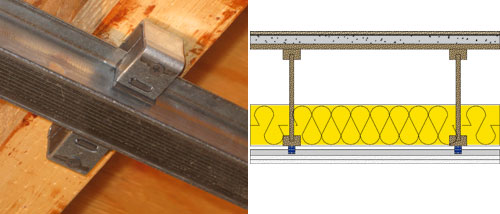 |
Gypsum concrete, ¾ in. plywood, 14 in. I-joist and 6 in. fiberglass insulation plus sound isolation clips have an STC and IIC of 54 and 57 respectively.
Image provided by Kinetics Noise Control |
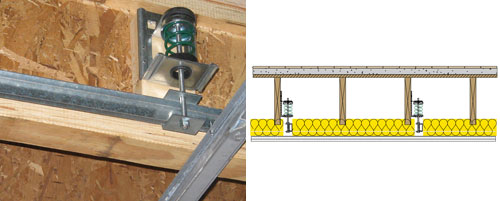 |
Saving valuable ceiling height, a wood-frame rubber and steel ceiling hanger is attached to 2 in. x 10 in. joists and suspends two layers
Image provided by Kinetics Noise Control |
 |
Examples of floating hardware ceiling assemblies using a leaf spring hanger.
Image provided by Kinetics Noise Control |
 |
Neoprene hanger supports one or more layers of gypsum board.
Image provided by Kinetics Noise Control |
 |
Secured to concrete, metal deck, or structural framing, this ceiling hanger supports one or more layers of gypsum board.
Image provided by Kinetics Noise Control |
 |
Low profile spring hanger saves ceiling space.
Image provided by Kinetics Noise Control |
 |
Combination of rolled insulation in concrete slabs plus an isolation hanger suspending sheetrock yields a very high STC and IIC.
Image provided by Kinetics Noise Control |
Sound isolation ceilings
Resilient isolation hangers that suspend drywall ceilings greatly improve STC and IIC.
Isolation clips. Designers wanting low-cost, space saving ceilings and walls that provide noise control have the option of using sound isolation clips. These attach to ceiling joists, wall studs, or masonry and secure the drywall furring channel. One or more layers of gypsum board are then hung to the furring channel.
Spring isolation hangers. These are best for low frequency sound or vibration. Secured to wood-frame construction (e.g., joists, trusses), a typical hanger incorporates a one-inch-rated deflection spring in series with a neoprene cup, and will resiliently support one or more layers of gypsum board.
Leaf spring hanger. Developed by one manufacturer the leaf spring hanger out-performs resilient channel and sound clips with or without gypsum concrete.
Fiberglass or neoprene hangers are lower cost, labor saving and effective in many applications.
Super-compact ceiling hanger. This low profile isolated hanger assembly may be specified when minimizing ceiling drop in an occupied space. It uses less than 3-1/2 in. of space and is often used in renovation projects.
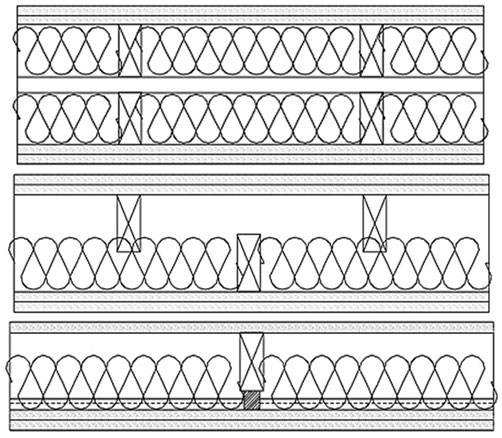 |
Compared with staggered stud construction, double stud wall design provides a higher STC value. Adding an isolation clip and gypsum board layers to a single stud wall increases STC.
Image provided by Kinetics Noise Control |
 |
Wall isolation clips increase STC.
Image provided by Kinetics Noise Control |
Stud wall framing design affects sound
The design of stud walls can significantly improve noise control. A single stud wall with a single gypsum board on each side has a low STC of 33. By redesigning the stud design and adding resilient isolation clips STC can be doubled.
Double stud. Double 2 x 4 stud wall with two layers of 5/8 gypsum board each side, provides STC 63.While effective for high STC, the two walls take additional floor space. Note, rigid bracing between walls, often done for fire rated design, will drastically lower the STC.
Staggered stud. While much less effective than double stud construction due to common base plates which transmit sound, staggered stud construction with an STC of 53 takes less floor space.
Resilient clip single stud. Using resilient isolation clips can provide a high STC of 61 and maximizes floor space.
Wall braces are available in different configurations and will isolate soffits, stud walls, plumbing and TV sound.
Floor Isolation System for Bowling Alley:
Galaxy Lanes at Plaza Las Americas:
San Juan, Puerto Rico
|
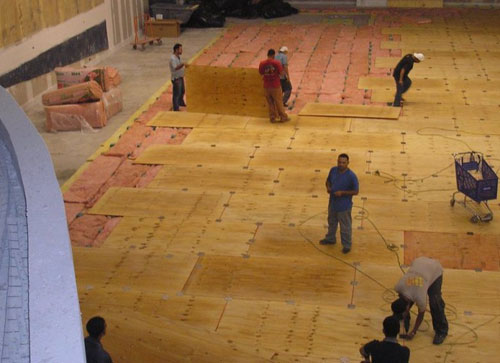 |
Roll-out batting with fiberglass isolators plus an addition layer of insulation was covered with a plywood pouring form.
Photo provided by Kinetics Noise Control |
When the owners of Galaxy Lanes at Plaza Las Americas proposed a 32-lane bowling alley be located on the third floor of the largest mall in the Caribbean, the mall owners and store operators on the floors below demanded that no sound of bowling balls and pins and no airborne music be heard during business hours. Typically, spring isolators supporting a concrete slab are chosen to address impact from bowling noise. However, once the cost and construction time of the system were understood, an alternative system was sought that used roll-out material with isolators.
Roll-out batting with 4-in.-tall fiberglass isolators inserted 24-in. on center plus an additional layer of batting was laid. A ¾-in.-thick plywood sheathing pouring form was installed on top and tied together using junction plates. Poly sheeting protected the pouring form. Altogether, two four-man crews each working 8-hour shifts, completed the task in three and a half days, ready for reinforcement and poring the concrete. The effort allowed the concrete contractor to start work a week early. The bowling alley manufacturer was then able to commence installation of the lanes as originally scheduled. |
Column and Floor Isolator Assemblies:
Kimmel Center Hamilton Terrace
Philadelphia, PA
|
 |
Spring isolators were placed with interconnecting steel framing members. A form deck will be installed and concrete poured to form the floor..
Photo provided by Kinetics |
Special spring assemblies were manufactured for isolating the columns and floor for the new Hamilton Terrace entertainment venue at Kimmel Center in Philadelphia, Pennsylvania, home of the legendary Philadelphia Orchestra. Engaged by the acoustical consulting firm Threshold Acoustics, the manufacturer was challenged with designing isolators to fully decouple the venue from the rest of the Kimmel Center structure. Two independent isolation systems were proposed, so that the variable live load on the isolated floor would not affect the isolation and detailing of the superstructure.
First, column isolators had to be designed to meet height requirements, provide vertical and lateral restraint, minimize demolition to the existing structural floor, facilitate easy installation at the jobsite, and meet the specified design frequency. Next, spring isolators were designed to allow steel structural members for the floor system to be connected. Accurate load information coupled with proper spring selection yielded a floating floor system capable of handling a varied dead load imposed across the floor and varying live load input, all without significant movement to the floor during events.
Opened during summer 2012, the column and floor isolators performed flawlessly. Critical to the success of this project were the manufacturer’s early involvement in the project with the design team and close coordination with the structural engineer of record. |
Conclusion
Architectural construction systems and finishes are engineered, designed and specified to deliver noise control. Strategies for controlling in-room noise include surface finish treatments such as acoustical panels that reflect, absorb and diffuse sound for a range of applications such as concert halls, swimming pools and auditoriums. Wall, floor and ceiling architectural framing designs that incorporate sound isolation products play a major role in controlling sound between rooms. Recognized as a significant factor in school design, adequate noise control is a growing requirement of building design and an increasing presence in LEED certification.
 |
Celebrating over 50 years, Kinetics Noise Control has extensive experience in designing and manufacturing innovative products to control sound and vibration. Established in 1958 as engineers focusing on sound and vibration control, Kinetics pioneered development of pre-compressed, molded fiberglass pad isolators that would be incorporated into an innovative new floor isolation system. Previous trade names of Kinetics Noise Control include Consolidated Kinetics and Peabody Noise Control. www.kineticsnoise.com |

















































